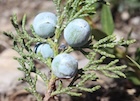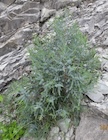Conservation Status

Juniperus polycarpos
K.Koch (1849)
Common names
Persian juniper, Turkestan juniper, Можжевельник многоплодный [Russian], عرعر فارسي [Arabic].
Taxonomic notes
Synonymy: see POWO. This is often treated as a subspecies or variety of J. excelsa, but species rank is appropriate in view of the substantial morphological, molecular, and ecological differences between the taxa, as well as their disjunct ranges (Adams 2004, Adams et al. 2008, Adams 2014, Adams et al. 2014). There are two subspecies, J. polycarpos subsp. polycarpos and J. polycarpos subsp. turcomanica (B.Fedtsch) Silba (2006). Subsp. turcomanica is usually treated as a variety per Adams (2004), but in view of its highly disjunct distribution and its ecological differences, subspecies rank is more appropriate. This is one of 8 species in a widely-distributed clade (Macaronesia to Japan) within Juniperus section Sabina. It is sister to J. excelsa and J. seravschanica.
Description
Trees (sometimes shrubs or prostrate shrubs) to 7 m tall, usually with a single trunk; crown broadly pyramidal in young trees, with age becoming broad, irregular, or shrub-like to prostrate in alpine locations. Bark first smooth, soon with papery flakes, reddish-brown, later fibrous, becoming longitudinally furrowed and peeling in long strips; purplish- to reddish-brown. Twigs numerous, irregularly disposed; ultimate twigs covered with leaves, quadrangular, diameter only 1-1.3 mm. Juvenile leaves on seedlings or on lower, shaded branches of trees are ternate, acicular, c. 8-10 x 1 mm, widest at base, keeled, pungent; mature leaves scale-like, decussate, imbricate, appressed or free at apex, decurrent at base, ovate-rhombic on ultimate branchlets, (ob)lanceolate-acute on older shoots (-3.5 mm long), 1.2-1.6 × 0.8-0.9 mm, with entire margins; glands large and conspicuous, elliptic to nearly circular, often resinous; stomata on juvenile leaves epistomatic, on mature leaves amphistomatic, mostly in 2 inconspicuous lines tapering from base to apex, light green or yellowish-green; both juvenile and mature leaves have a single median resin cavitv. Pollen cones numerous, solitary and terminal or subterminal on ultimate branchlets, 3-4 × 2-3 mm, greenish maturing yellowish; microsporophylls 8-10, peltate with rounded, thin margins, each bearing 3-4 pollen sacs. Seed cones numerous, mostly solitary and axillary, subterminal on ultimate branchlets, sessile; young cones surrounded by green leaves or bracts, 2-3 mm diameter, purplish-green to blue; mature cones globose, 10-14 mm diameter, purplish-brown to blackish-purple, often pruinose; seed scales 4(-6), decussate, entirely fused with bracts and each other, the two largest meeting at the distal pole of the cone, 4-9 mm long, surface smooth, waxy, with a ridge terminating in a small umbo (0.5-0.6 mm), interior resinous, becoming woody, yellowish. Seeds (2-)3-4(-6) per cone (some ovules usually abort), angular, broadest at base, ovoid but flattened or curved, 4-6 × 3-4 mm, yellowish to reddish-brown (Farjon 1992).
Adams (2014) provides the following key to distinguish subsp. polycarpos, subsp. turcomanica, and J. seravschanica:
| 1a. |
Smallest twigs 0.7-0.8 mm diameter, scale leaves tightly appressed, seed cones 7-9(-10) mm diameter, (1-)2-3(-4) seeds per cone. |
J. polycarpos subsp. turcomanica |
| 1b. |
Smallest twigs 0.9-1 mm diameter, scale leaves with a beak or keel so the twig appears as a string of beads, seed cones 8-11 mm diameter, 3-6 seeds per cone. |
2. |
| 2a. |
At least some scale leaves with very narrow, elongated, brown glands, not ruptured. Seed cones 9-11 mm diameter. |
J. polycarpos subsp . polycarpos |
| 2b. |
Scale leaves with clear, ellipsoid glands, often ruptured with a clear exudate. Seed cones 8-10 mm diameter. |
J. seravschanica |
Distribution and Ecology
The type variety is in Azerbaijan and border areas of adjoining countries: Armenia, Georgia, Iran, Kazakhstan, Russia, Turkmenistan, at elevations of 300-2500 m, usually as solitary trees or shrubs but sometimes with other junipers, forming forests (Adams 2014). Farjon (1992) also places it from the mountains around the Çoruh Valley in E Turkey, eastwards to the Caspian Sea, and notes that it occupies areas with a substantially drier and more continental climate than the Mediterranean J. excelsa, but somewhat wetter and warmer than the climates associated with J. seravschanica.
The IUCN assesses the conservation status of this species as "Least Concern", due largely to its extremely large area of occurrence. However, that analysis conflates J. polycarpos and J. seravschanica, also the assessment has not been updated since 2011 (Farjon 2013). Adams (2014) regards the species as threatened due to goat grazing.
Remarkable Specimens
The age record is 318 years, derived from a cut tree used in a dendroclimatic study (Liphschitz et al. 1979).
Ethnobotany
The wood is used in building and carpentry (Adams 2014).
Liphschitz et al. (1979) used this species in an exploratory dendroclimatic study in the Elburz Mountains. Trees were sampled by cross-sectioning; they found trees up to 318 years old, succeeded in crossdating samples and developing a master chronology, and found that growth was strongly positively correlated with fall precipitation and fall temperature.
Observations
No data as of 2025.01.09.
Remarks
The epithet polycarpos means "many-seeded"; perhaps it was discovered during a mast year when the trees bore an exceptionally large cone crop.
Citations
Adams, Robert P. 2004. Juniperus deltoides, a new species, and nomenclatural notes on Juniperus polycarpos and J. turcomanica (Cupressaceae). Phytologia 86(2):49–53.
Adams, Robert P. 2014. Junipers of the World: The Genus Juniperus. Fourth edition. Trafford Publishing. Brief versions of the descriptions are available online at Adam's website, www.juniperus.org.
Adams, Robert P., Julie A. Morris, and Andrea E. Schwarzbach. 2008. Taxonomic study of Juniperus excelsa and J. polycarpos using SNPs from nrDNA and Cp trnC-trnD plus essential oils and RAPD data. Phytologia 90(2):216–33.
Adams, Robert P., Boucha Douaihy, Magda Dou Dagher-Kharrat, Andrea E. Schwarzbach, and Vahid Farzaliyev. 2014. Geographic variation in nrDNA and four cpDNA regions of Juniperus excelsa and J. polycarpos from Greece, Turkey, Lebanon and Azerbaijan. Phytologia 96(2):89–95.
Farjon, A. 2013. Juniperus excelsa subsp. polycarpos. The IUCN Red List of Threatened Species 2013: e.T16336635A16336647. https://dx.doi.org/10.2305/IUCN.UK.2013-1.RLTS.T16336635A16336647.en, accessed 2025.01.09.
Koch, K. 1849. Linnaea 22:303. Available: Biodiversity Heritage Library, accessed 2025.01.09.
Liphschitz, N., Y. Waisel and S. Lev-Yadun. 1979. Dendrochronological investigations in Iran. Tree-Ring Bulletin 39:39-45.
See also
Adams, Robert P., and Parvin S. Shanjani. 2011. Identification of the Elburz Mountains, Iran juniper as Juniperus polycarpos var. polycarpos. Phytologia 93:316–21.
Adams, Robert P., Boucha Douaihy, Magda Dou Dagher-Kharrat, Vahid Farzaliyev, Alexander N. Tashev, K. Husnu Can Baser, and A. K. Christou. 2014. Geographic variation in the volatile leaf oils of Juniperus excelsa and J. polycarpos. Phytologia 96(2):96–106.






